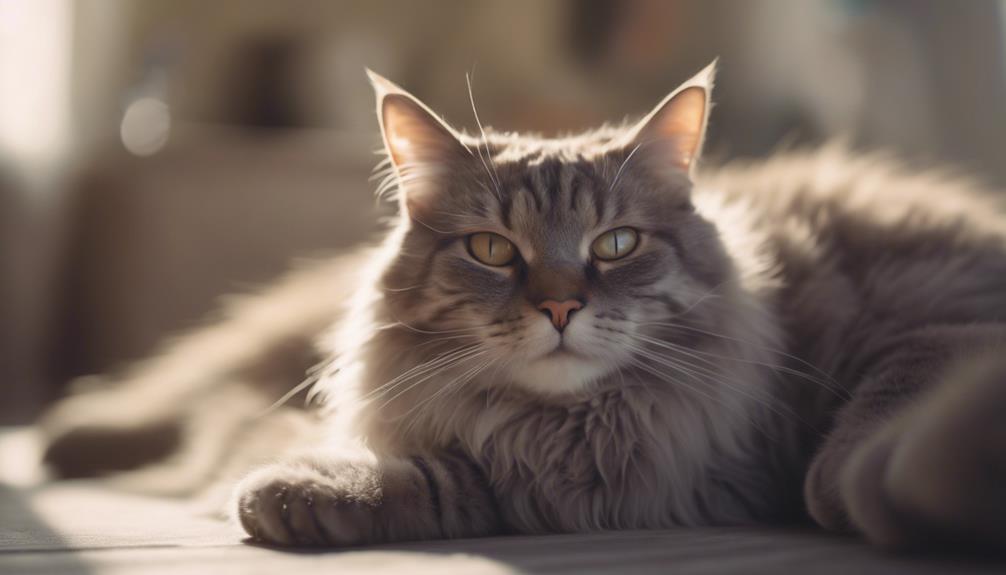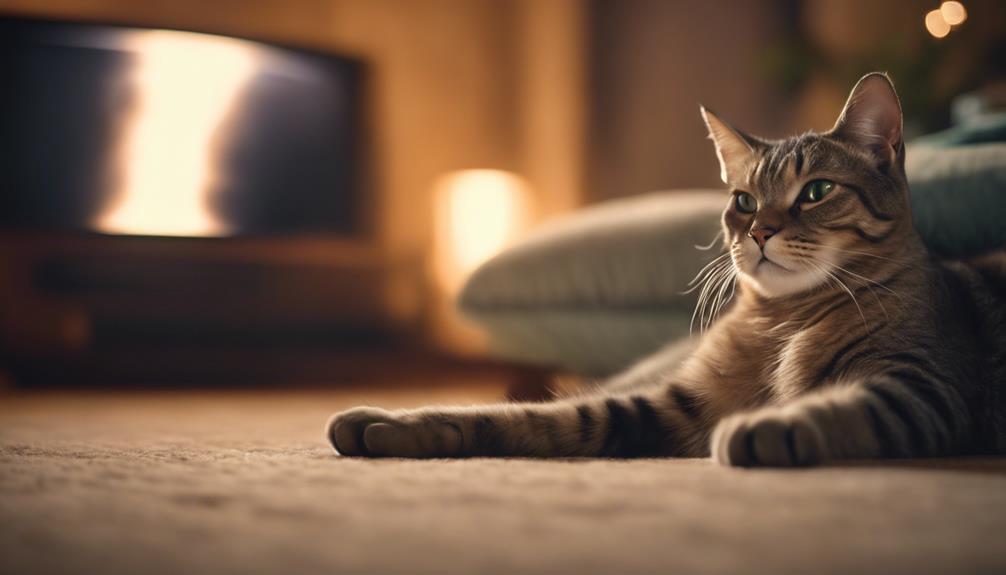What Are Effective Ways to Reduce Fear in Cats?

Effective Ways to Reduce Fear in Cats:
Understanding their triggers and behaviors, and implementing targeted interventions can help guide your feline friend towards a calmer state.
Understanding Your Cat's Triggers
Understanding your cat's triggers can greatly assist in identifying and addressing sources of fear and anxiety in your feline companion. By actively observing your cat's behavior, you can start identifying specific triggers that may be causing distress. Pay attention to behavioral patterns such as hiding, hissing, or excessive grooming, as these could indicate stressors in your cat's environment.
Once you have pinpointed potential triggers, you can begin implementing calming techniques to help alleviate your cat's fear. This may include creating a safe space for your cat to retreat to or using pheromone diffusers to promote relaxation. Additionally, desensitization training can be a valuable tool in helping your cat overcome their fears by gradually exposing them to the trigger in a controlled and positive manner.
If you find it challenging to identify or address your cat's triggers effectively, seeking professional guidance from a veterinarian or animal behaviorist can provide valuable insights and support in managing your cat's anxiety.
Providing Safe and Secure Spaces

Creating a safe and secure environment for cats is crucial in reducing their fear and anxiety.
Providing hideaway spots allows them to retreat to a cozy space when feeling overwhelmed.
Elevated perches offer a sense of security, while enclosed spaces can help cats feel protected and calm.
Hideaway Spots for Comfort
To help reduce fear in cats, providing hideaway spots for comfort is essential. Cats often feel safer and more secure when they have a cozy nook or hidden retreat to retreat to when feeling anxious or overwhelmed. Here are some key points to consider when creating hideaway spots for your feline friend:
- Cozy Nooks: Cats appreciate small, enclosed spaces that make them feel protected.
- Hidden Retreats: Offering secluded areas where cats can relax away from noise and commotion can help alleviate their stress.
- Soft Bedding: Providing soft blankets or cushions in these hideaway spots can enhance their comfort.
- Multiple Options: Having multiple hideaway spots throughout your home gives your cat choices and control over their environment.
Elevated Perches for Security
When seeking additional ways to enhance your cat's sense of security, consider incorporating elevated perches into their environment. Cats naturally seek out high vantage points for safety and observation, making climbing structures a valuable addition to their space.
Providing secure vantage points not only offers a sense of security but also allows cats to relax in their comfort zones. These elevated perches can be in the form of cat trees, shelves, or window perches, giving your feline companion various options to choose from.
Enclosed Spaces for Safety
Consider providing your cat with enclosed spaces that offer a sense of safety and security in their environment. Cats often seek out cozy nooks where they can feel protected and calm. Here are some tips to create safe havens for your feline friend:
- Use covered beds or igloos: These enclosed spaces mimic a cat's natural instinct to seek shelter.
- Provide hiding spots: Cardboard boxes or cat caves offer a secluded area for your cat to retreat to.
- Utilize cat trees with cubbies: Multi-level structures with enclosed areas allow cats to observe from a secure vantage point.
- Incorporate soothing scents: Consider using pheromone diffusers to promote relaxation in these enclosed spaces.
These feline relaxation techniques can help in anxiety reduction and provide comfort for your beloved pet.
Implementing Positive Reinforcement Techniques

When helping cats overcome fear, using positive reinforcement techniques can make a significant difference in their emotional well-being.
Rewarding desired behaviors, engaging in play to build trust, and creating a calm environment are essential strategies to implement.
Rewarding Desired Behaviors
To effectively reinforce desired behaviors in cats, consistently reward them with treats or praise immediately after they exhibit the behavior. This positive reinforcement technique can help reduce fear in cats by associating good behavior with pleasant outcomes.
Here are some key points to keep in mind when rewarding desired behaviors:
- Use high-value treats to make the reward more enticing.
- Be prompt and consistent in providing rewards to reinforce the behavior effectively.
- Combine treats with verbal praise to create a positive association with the desired behavior.
- Monitor your cat's response to different rewards to determine what motivates them the most.
Building Trust Through Play
Building trust through engaging play activities is pivotal in implementing positive reinforcement techniques to reduce fear in cats. Trust building can be achieved through interactive toys that stimulate the cat's natural instincts, encouraging playtime bonding between the cat and its owner.
By engaging in play sessions with interactive toys, the cat learns to associate positive experiences and rewards with human interaction, fostering a sense of security and comfort. Additionally, incorporating treats during playtime can further strengthen the bond and create positive associations with the owner.
This process helps the cat feel more at ease in their environment and with the people around them, ultimately reducing fear and anxiety. Effective trust-building activities set the foundation for a strong and positive relationship between the cat and its owner.
Calm Environment Setup
Creating a calm environment for your cat involves strategically implementing positive reinforcement techniques that promote a sense of security and well-being. To help reduce fear in cats, consider the following:
- Soothing music: Playing calming music can create a relaxing atmosphere for your cat.
- Comforting scents: Using pheromone diffusers or sprays can help reduce anxiety and create a sense of security.
- Relaxing toys: Interactive toys like puzzle feeders or laser pointers can provide mental stimulation and help alleviate stress.
- Cozy bedding: Providing soft, comfortable bedding in quiet, secluded areas allows your cat to have a safe space to retreat to when feeling anxious.
Utilizing Pheromone Products

Using pheromone products can help alleviate fear and anxiety in cats by creating a calming environment through scent signals. These products mimic natural pheromones that cats release, helping them feel safe and secure in their surroundings. Two common types of pheromone products are pheromone diffusers and anxiety wraps.
| Pheromone Diffusers | Anxiety Wraps | Benefits |
|---|---|---|
| Emit synthetic cat pheromones | Wrap around the cat's body | Creates a consistent calming effect |
| Plug into an outlet | Apply gentle pressure | Reduces stress during travel or vet visits |
| Cover an area of 500-700 sq. ft. | Provide a sense of security | Helps in managing fear-related behaviors |
Pheromone diffusers are ideal for creating a peaceful atmosphere in the home, while anxiety wraps are beneficial for specific stressful situations. By incorporating these products into a cat's environment, pet owners can effectively reduce fear and anxiety, promoting their feline companion's well-being.
Creating Calm and Consistent Environments

To establish a sense of security and ease for cats, maintaining a consistently calm environment is crucial in promoting their emotional well-being. Cats thrive in environments where they feel safe and comfortable. Here are some effective strategies to create a peaceful atmosphere for your feline friend:
- Comfort zones: Provide cozy hiding spots or elevated perches where your cat can retreat to when feeling stressed.
- Routine schedules: Stick to a consistent daily routine for feeding, playtime, and quiet periods to help your cat feel secure and reduce anxiety.
- Interactive play: Engage in interactive play sessions to stimulate your cat's mind and body, promoting relaxation and reducing pent-up energy.
- Relaxation techniques: Implement calming methods such as gentle petting, soothing music, or using pheromone diffusers to create a serene environment.
Gradual Desensitization Training

Implementing a gradual desensitization training plan can help cats overcome their fears and anxieties in a controlled and systematic manner. This method involves exposing the cat to the source of fear in a slow and gradual manner, allowing them to adjust at their own pace. By introducing the fearful stimulus in manageable increments, such as increasing proximity to the trigger over time, cats can learn to feel more comfortable and less threatened. It's crucial to create controlled environments during this process to ensure the cat's safety and well-being.
Through patience and consistency, caregivers can help their feline companions build confidence and reduce fear responses. For example, if a cat is scared of loud noises, starting with playing a recording of the noise at a low volume and gradually increasing it can help desensitize the cat over time. By providing positive reinforcement, such as treats or favorite toys, during these desensitization sessions, cats can associate the feared stimulus with something pleasant, further aiding in their emotional healing.
Seeking Professional Veterinary Guidance

Seeking guidance from a professional veterinarian can provide essential support in addressing and managing your cat's fears and anxieties effectively. Veterinary professionals have the expertise to identify the root cause of your cat's fear and develop a tailored plan to help them overcome it. When it comes to behavior modification and anxiety management in cats, veterinarians play a crucial role in guiding pet owners on the right path. Here are some reasons why seeking professional veterinary guidance is vital:
- Accurate Diagnosis: Veterinarians can accurately diagnose your cat's fears and anxieties, ensuring the right approach is taken.
- Customized Treatment Plans: They can develop customized behavior modification and anxiety management plans based on your cat's specific needs.
- Medication Management: If necessary, veterinarians can prescribe medications to help alleviate your cat's anxiety.
- Ongoing Support: Veterinary professionals offer ongoing support and guidance throughout the treatment process, ensuring your cat's well-being is continuously monitored and adjusted as needed.
Frequently Asked Questions
Can Fear in Cats Be Completely Eliminated, or Is It Something That Will Always Be Present to Some Extent?
Fear in cats, though a natural instinct, can be managed effectively through behavior modification. While complete elimination may not always be possible, long-term progress can be achieved by identifying and addressing specific fear triggers.
Are There Any Specific Breeds of Cats That Are More Prone to Fear and Anxiety?
Certain cat breeds, like Siamese and Persian, exhibit higher susceptibility to fear and anxiety triggers due to genetic predisposition. Behavior modification techniques, such as gradual desensitization and creating safe spaces, can help alleviate these tendencies.
How Long Does It Typically Take for a Cat to Show Improvement in Their Fear Levels With the Recommended Techniques?
Behavior modification and gradual desensitization can lead to improvement in a cat's fear levels. Consistency and patience are key. On average, visible progress can be seen within a few weeks to a couple of months with dedicated efforts.
Are There Any Alternative Therapies or Treatments That Can Be Used in Conjunction With the Mentioned Methods to Reduce Fear in Cats?
In conjunction with the mentioned methods, herbal remedies, behavior modification, aromatherapy, and acupuncture can be alternative therapies to reduce fear in cats. These complementary approaches can enhance the overall well-being of feline companions.
What Should Pet Owners Do if Their Cat's Fear and Anxiety Seem to Be Worsening Despite Implementing These Strategies?
When a cat's fear and anxiety worsen despite efforts, pet owners should consider behavior modification, medication, professional help, and desensitization techniques. It's crucial to seek guidance from a veterinarian to address the issue effectively.











